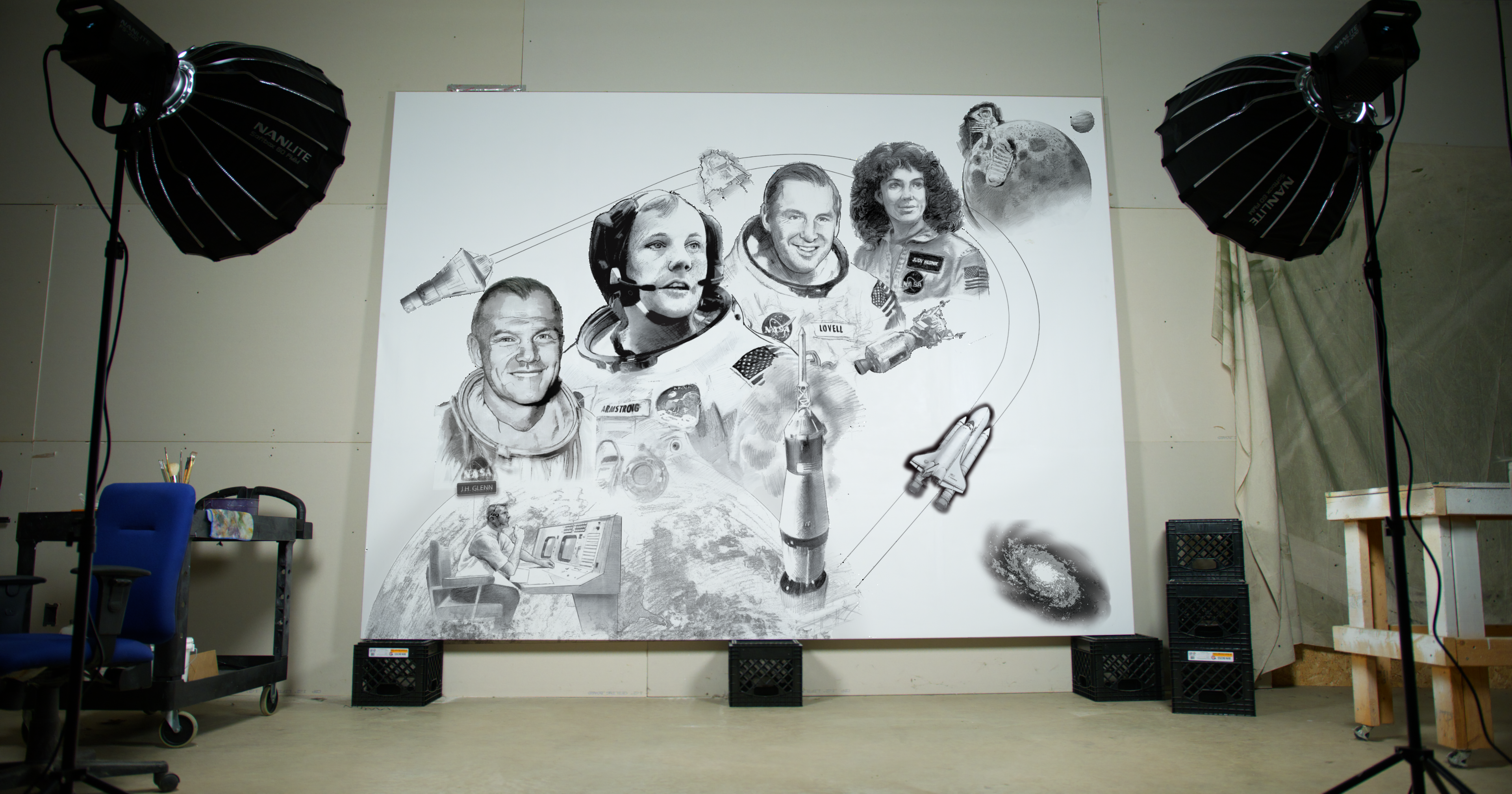In the quaint village of Hicksville, Ohio, Bill Hinsch’s interest in space missions was piqued. So was his artistic journey that would someday launch his artwork to heights he never would have imagined. He remembers doodling and making enthusiastic rocket noises while famous newsman Walter Cronkite narrated John Glenn’s legendary orbit around the Earth, a springboard for the gripping stories of space travel yet to come.
The now well-known portrait artist was fourteen years old when Neil Armstrong took his first steps on the moon—a monumental event that close to 600 million Americans witnessed and supported from Earth. He also recalls failure turning into success when Jim Lovell piloted Apollo 13 and when Judy Resnik, along with six other astronauts, lost her life in the Challenger disaster of 1986.
Hinsch’s decision to infuse his artwork with space exploration took off when he worked as the art director for the Blade and met Harley Copic, an internationally renowned pioneer of aviation art. Copic led Hinsch to join the United States Air Force Art Program, where fantastic illustrators created one painting per year to be showcased at a gala hosted by the Secretary of the Air Force in Washington DC. Years spent creating artwork for the program along with a newfound exposure to aviation art truly sparked Hinsch’s passion for space history.
To honor Ohio’s achievements in space travel, The Capitol Square Review and Advisory Board invited artists to paint a tribute to the astronauts of Ohio. With the USAF Art program and fifteen paintings hanging in the Pentagon under his belt, Hinsch naturally applied. His concept competed with two other remarkable artists: Leslie Adams from Toledo and James Pate from Dayton.
Due to his brilliant layout, Hinsch’s painting came out on top, launching a new era of remembrance to Ohio’s achievements in space exploration. The piece connects Ohio’s four most prominent space heroes along with their machines, struggles, and glory. “Ohioans in Space” features John Glenn from New Concord, Neil Armstrong from Wapakoneta, Jim Lovell from Cleveland, and Judy Resnik from Akron. These astronauts are painted as a human stairway from Earth to the Moon, since landing on the Moon was the main goal in early space travel.
John Glenn lived his entire life with a passion for space. At only eight years old, his father took him on his first flight expedition in an open-cockpit biplane—a ride that filled his young soul with a love for flying. He spent his early adult years in the U.S. Army Air Corps and later spent World War II doing extraordinary work as a pilot in the U.S. Marine Corps.
Aboard the Friendship 7 spacecraft in 1962, Glenn became the first American astronaut to orbit the Earth—which he did three times—and gave the U.S. a leg up in the space race with the Soviet Union, home to the first man to orbit the Earth. Glenn later became the oldest man to fly into space when, as an experiment to study the process of aging, he flew on the Discovery at 77 years old.
Neil Armstrong’s first footsteps on the moon are internationally known and remembered. He took flight for the first time at the age of six, a moment that inspired his zeal for outer space. In 1962, he piloted the Gemini 8 and used the first manual docking manoeuvre when the spacecraft spun out of control. His moon landing resulted from his mission in the Apollo 11 spacecraft—the height of his career and early space travel.
In 1968, Jim Lovell took his first flight around the Moon with the crew of the Gemini 7, in preparation for humanity’s first moon landing. He later commanded Apollo 13, which ended up malfunctioning halfway between Earth and the Moon. This tragedy forced the three men aboard the aircraft to exit the main Space Module to stay on the Lunar Module until they could swing back around and plop safely in the Pacific Ocean. Lovell is known as the first astronaut to fly into space four times and take two trips around the Moon.
In the third class of space exploration, NASA began to add minorities and women to their missions. Judy Resnik was the second woman to enter space, flying with the crew of the first Discovery space shuttle launch in 1984. Resnik helped create the Canadian Robotic Arm and used her expertise to operate it on the shuttle. Her second space mission was on the Challenger, which took mere seconds to explode, killing Resnik and her crew in the tragic accident.
Back on Earth, Gene Kranz is pictured and symbolizes the army of NASA workers supporting the launches as the brains from below. Kranz served as NASA’s mission controller and invented the space shot when Lovell and his crew got stuck between Earth and the Moon. He used the gravity on the moon to slingshot the astronauts back to the Pacific Ocean near Houston, Texas. Hinsch painted the route of the space shot weaving around the Earth and Moon, uniting the elements on the canvas in an eternity symbol.
The orange-tipped shuttle directly under Lovell is the Challenger, where Judy Resnik took her first flight. It connects in a U shape to a painting of the Discovery in motion—an innuendo to John Glenn’s flight on the same shuttle fourteen years after Resnik’s.
Apollo 11’s Lunar Module, “Eagle,” is painted near the top of the piece, between Glenn and Lovell. This vehicle transported Neil Armstrong and LM pilot Edwin Aldrin to their successful arrival on the Moon. Armstrong is also painted on the Moon, saluting the American flag.
Above Gene Kranz is the Mercury-Atlas 6 (also known as Friendship 7), Piloted by John Glenn in his 1962 orbit around the Earth.
Just under Glenn sits a giant white space launch vehicle, the Atlas V. This vehicle was developed for the Mars Science Laboratory mission to gain a better understanding of the weight and hardware requirements needed to land humans on Mars, which is painted behind the Moon. It was launched for the first time in November of 2020 and brought humanity one step closer to walking on another planet—representing today’s goals for space missions.
“Ohioans in Space” both honors the astronauts who revolutionized American space travel and is the peak of Hinsch’s artistic career. It connects the achievements of Ohio’s space heroes to our current goals for the future in an artistically brilliant way, showcasing the undying courage of these astronauts in the midst of the unknown. After the unveiling of this painting at the Ohio Statehouse Rotunda, Ohioans for generations to come will remember those who changed the trajectory of space exploration—no matter the cost.


